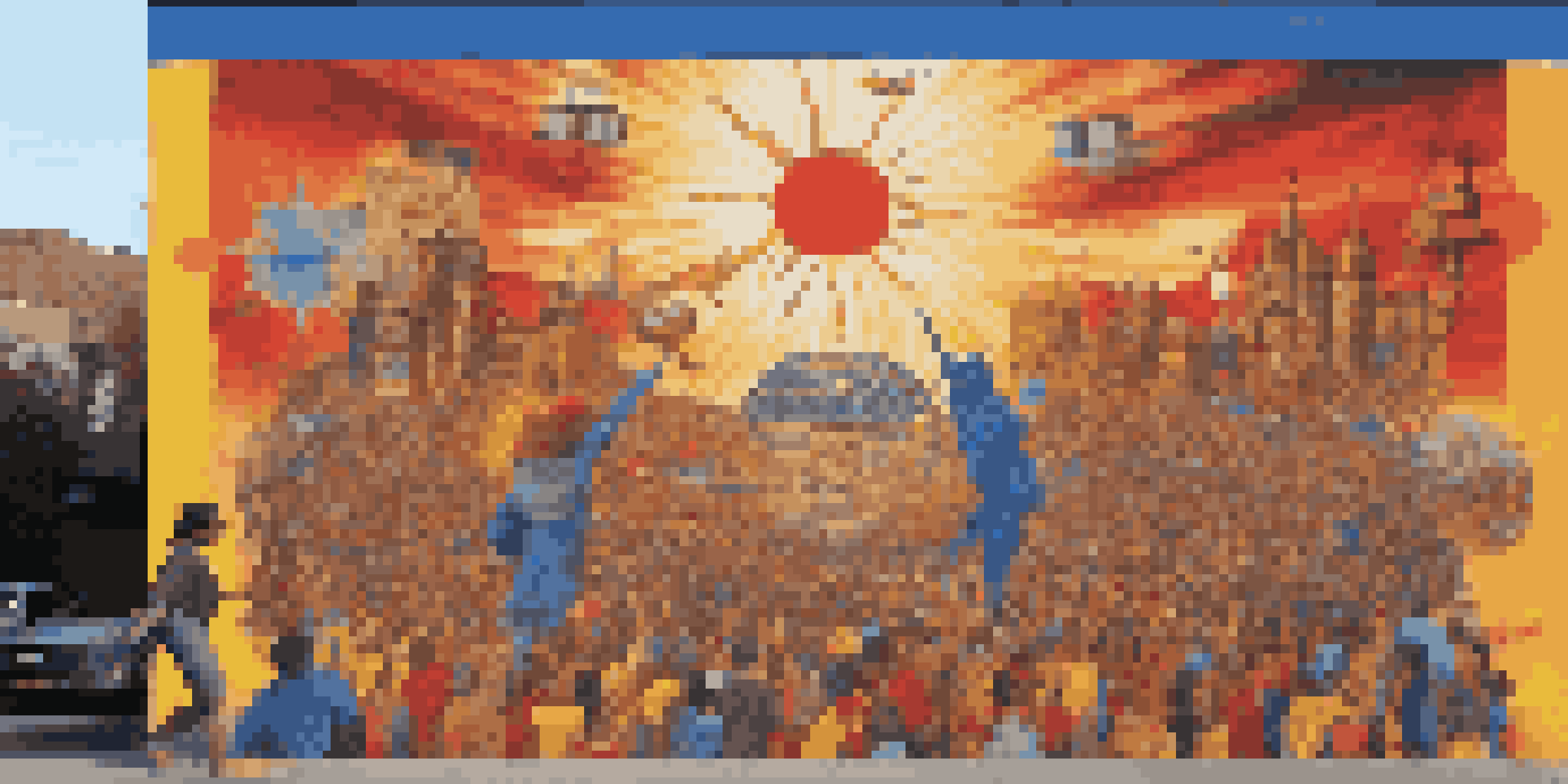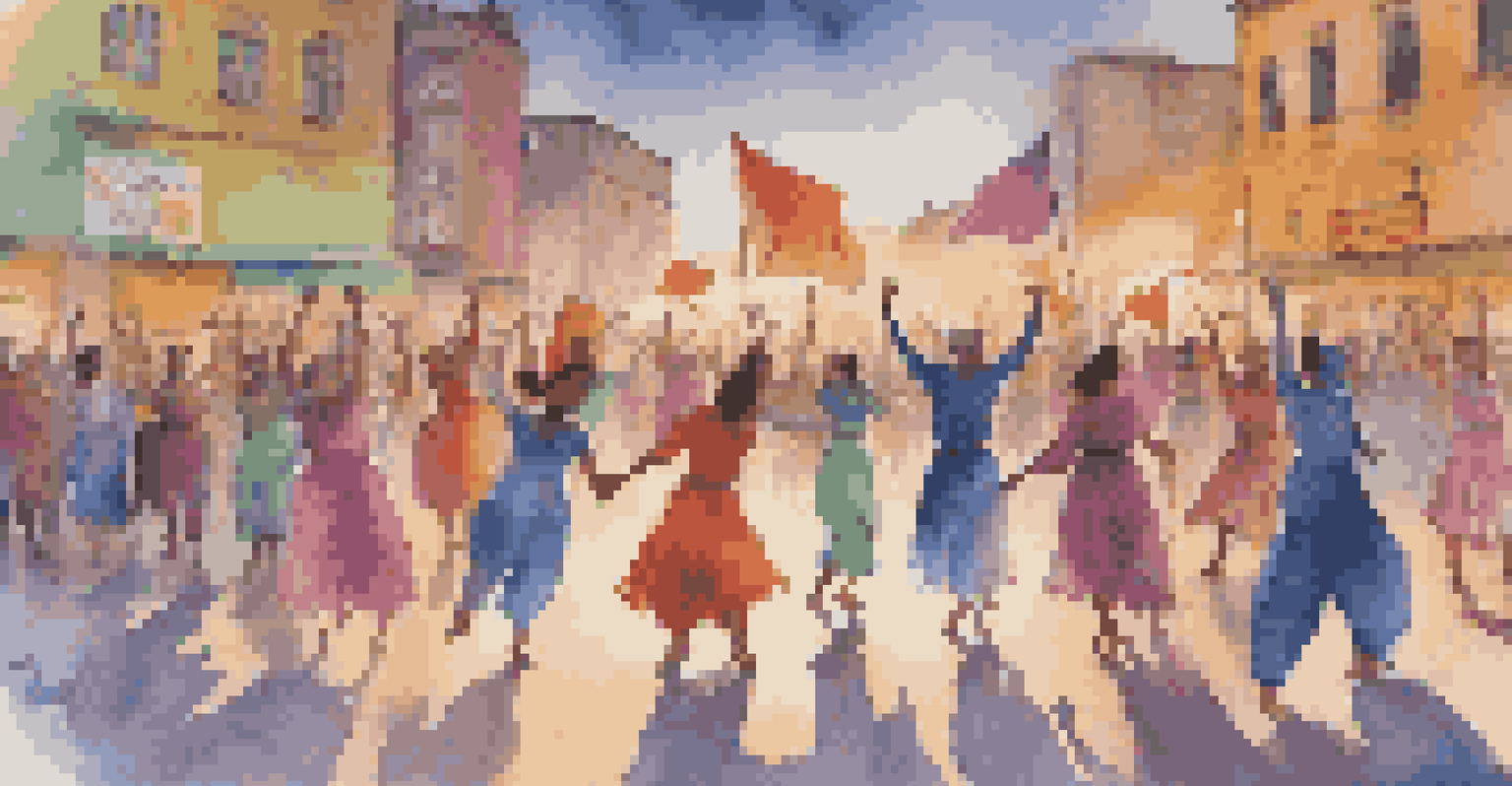Exploring the Role of Art in Anti-Globalization Movements

Understanding Anti-Globalization Movements
Anti-globalization movements arise from concerns about the negative impacts of globalization, such as economic inequality and cultural homogenization. These movements advocate for local sovereignty, environmental protection, and social justice. By challenging the dominance of multinational corporations, they aim to create a fairer global system that prioritizes human rights over profit.
Art should comfort the disturbed and disturb the comfortable.
Historically, these movements gained momentum in the late 20th century, particularly during events like the 1999 Seattle WTO protests. Activists rallied together, highlighting the adverse effects of trade agreements on workers and communities. This global discontent set the stage for a unique intersection of activism and art, where creative expression became a powerful tool for change.
Art serves as a voice for the marginalized, translating complex issues into relatable narratives. It can provoke thought, inspire action, and build solidarity among diverse groups. This is where the role of art becomes vital in the anti-globalization narrative, transforming abstract ideas into tangible, visual messages.
Art as a Form of Protest
Art has long been a medium for protest, giving individuals a platform to express dissent. From graffiti on city walls to large-scale murals, artists can convey powerful messages that resonate with the public. This visual language often bypasses barriers of literacy and language, making it accessible to a wider audience.

For instance, the iconic 'We Are the 99 Percent' slogan, paired with striking imagery, captured the essence of the Occupy Wall Street movement. Such artwork not only raised awareness but also fostered a sense of unity among participants. In this way, art becomes a rallying cry, galvanizing communities to stand against perceived injustices.
Art Amplifies Anti-Globalization Voices
Art serves as a powerful medium for protest, enabling activists to communicate complex messages and foster community solidarity against globalization.
Moreover, artistic protests often attract media attention, amplifying their messages beyond local communities. By creating visually appealing and thought-provoking work, artists can engage a broader audience, encouraging dialogue about globalization's impact. This strategic use of art is essential in keeping the anti-globalization discourse alive.
Visual Art and Globalization Critique
Visual art plays a crucial role in critiquing globalization by highlighting its effects on local cultures and economies. Artists often incorporate elements from their own heritage, juxtaposed with global symbols, to illustrate the tension between local identity and global influence. This creates a dialogue around cultural preservation and the threats posed by globalization.
The role of the artist is to make the revolution irresistible.
An example can be seen in the works of artists like Ai Weiwei, whose installations comment on issues like migration and human rights. Through provocative visual narratives, he challenges audiences to confront uncomfortable truths about the global political landscape. This interplay of art and activism fosters a deeper understanding of globalization's multifaceted consequences.
Art also serves as a historical record, capturing the essence of resistance movements. By documenting protests and the experiences of marginalized groups, artists contribute to a collective memory that informs future generations. This historical perspective is vital in sustaining the anti-globalization narrative.
Performative Art in Activism
Performative art, including theater and dance, engages audiences on an emotional level, making complex political issues more relatable. Activists often use performance to dramatize the struggles caused by globalization, creating an immersive experience that prompts reflection and action. This type of art can humanize abstract statistics and facts, grounding them in real-life experiences.
For instance, the 'One Billion Rising' campaign utilized dance as a form of protest against violence towards women, merging art with activism. Participants around the globe joined in choreographed performances, illustrating solidarity against a common issue. This powerful combination of movement and message amplifies the call for change.
Digital Platforms Enhance Activism
The rise of digital art and social media has expanded the reach of anti-globalization messages, allowing for global collaboration and engagement.
The interactive nature of performative art also encourages community participation, fostering a sense of belonging among activists. It transforms passive viewers into active participants, creating a shared experience that strengthens the movement's impact. Through the lens of performance, the anti-globalization narrative becomes a living, breathing entity.
Street Art: A Voice for the Voiceless
Street art has emerged as a prominent form of expression within anti-globalization movements, often addressing social and political issues in public spaces. With its accessibility and visibility, street art reaches a diverse audience, making it an effective tool for activism. Artists utilize this medium to challenge the status quo and provoke conversations about power dynamics.
Globally recognized street artists, like Banksy, have used their work to comment on issues such as consumerism and war. His pieces often convey sharp critiques of globalization, using humor and irony to engage viewers. This approach not only entertains but also invites people to reflect on the implications of their consumption habits.
Moreover, street art can act as a form of reclaiming public space, challenging corporate advertising and dominant narratives. By transforming urban environments into canvases for dissent, artists create alternative dialogues that celebrate local culture. This reclamation is essential in countering the homogenizing effects of globalization.
Digital Art and Global Activism
In the digital age, art has found new avenues for expression and activism. Social media platforms allow artists to share their work widely and connect with global audiences, amplifying their messages. Digital art can easily cross borders, creating a virtual space for collaboration and dialogue around anti-globalization themes.
For example, online campaigns using digital art have successfully raised awareness about environmental issues linked to globalization, such as deforestation and climate change. Artists create striking graphics and animations that highlight these urgent problems, encouraging viewers to take action. This democratization of art empowers individuals to become advocates for change.
Art Documents Resistance Movements
Visual and performative art not only critiques globalization but also captures the essence of resistance, preserving the narratives of marginalized groups for future generations.
Additionally, digital art can serve as a form of resistance against censorship. In regions where traditional forms of protest are restricted, artists turn to digital platforms to voice their dissent. This adaptability ensures that the anti-globalization movement remains vibrant and resilient, even in the face of challenges.
The Future of Art in Anti-Globalization Movements
As globalization continues to evolve, the role of art in activism will likely expand and adapt. Artists will continue to explore innovative ways to address pressing issues, using their creativity to inspire change. The intersection of technology and art may lead to new forms of expression that resonate with younger generations.
Moreover, as movements become more interconnected globally, collaborative art projects could foster greater solidarity among activists. By working together across cultures, artists can create powerful statements that transcend borders, highlighting shared struggles and aspirations. This collective approach may redefine the anti-globalization narrative in the coming years.

Ultimately, the enduring power of art lies in its ability to evoke emotion and provoke thought. As long as there are injustices to confront, artists will find ways to use their craft as a catalyst for change, ensuring that the anti-globalization message remains relevant and impactful.